Performing regular maintenance checks helps avoid covering the expenses of replacing the entire HVAC system. Nevertheless, to repair or replace a malfunctioning air conditioning or heating system, you need to know how to find the best HVAC tools.
HVAC technicians use a broad range of tools that spans from general hand tools such as the tape measure or pliers to HVAC specialty tools like nitrogen regulators or core removal tools.
Ultimately, the company you’re working for should provide some of the specialized HVAC tools, but you can’t rely on your employer to supply you with all the tools you’re going to need for the HVAC job. Also, tools are one of the first things you’ll have to invest in if you decide to set up a privately owned HVAC service.
So, in this article, we’re going to show you how to find the best HVAC tools and choose the models that are best suited for your HVAC toolkit.
HVAC training resources
Whether or not you can become an HVAC technician without a license depends on the state you live in, but even if you decide against acquiring the HVAC certification, you’ll still have to complete the HVAC apprenticeship, which can take you more time than completing an HVAC training course.
It takes between 2 and 5 years to become a licensed HVAC technician, but you should keep in mind that the requirements of the courses aren’t the same in all states.

Even so, most states recognize NATE (North American Technician Excellence) certificates, as they’re issued by the nation’s largest HVAC certification organization.
You can also obtain four different types of certificates through EPA and specialize in working with home appliances or get a universal certificate that makes you eligible to service all types of HVAC systems.
Besides, completing HVAC training courses and becoming a certified HVAC technician enables you to know which tools you will need to complete different types of HVAC maintenance and replacement jobs.
Compiling an HVAC toolset
Building an HVAC toolset from scratch can be a challenge as there are so many pieces of equipment you can add to your tool bag. As a technician, you’ll perform most of your work on-site, which means that you’ll have to carry the HVAC tools with you.
Instead of trying to include all the HVAC tools you can get into your kit, you should assess which tools you’re going to be using the most. For instance, there’s no need to get sheet metal tools if you’re not expecting to install UV lights or cut pieces of ducting pipes every day.
Your toolset should be adjusted to the type of HVAC reparation jobs you’re performing since home HVAC systems are generally easier to replace or repair than complex HVAC systems utilized at large commercial venues.
Your HVAC toolset should contain a combination of hand, specialized HVAC, and miscellaneous tools in either case.
See also: How to Find the Best Tool Bags.
Specialized HVAC tools
Checking the condition of an HVAC system without the tools that enable you to measure the refrigerant level, read the temperature inside the ductwork, or measure the air humidity is impossible. Hence, HVAC technicians must have access to the tools that allow them to perform job-specific tasks.
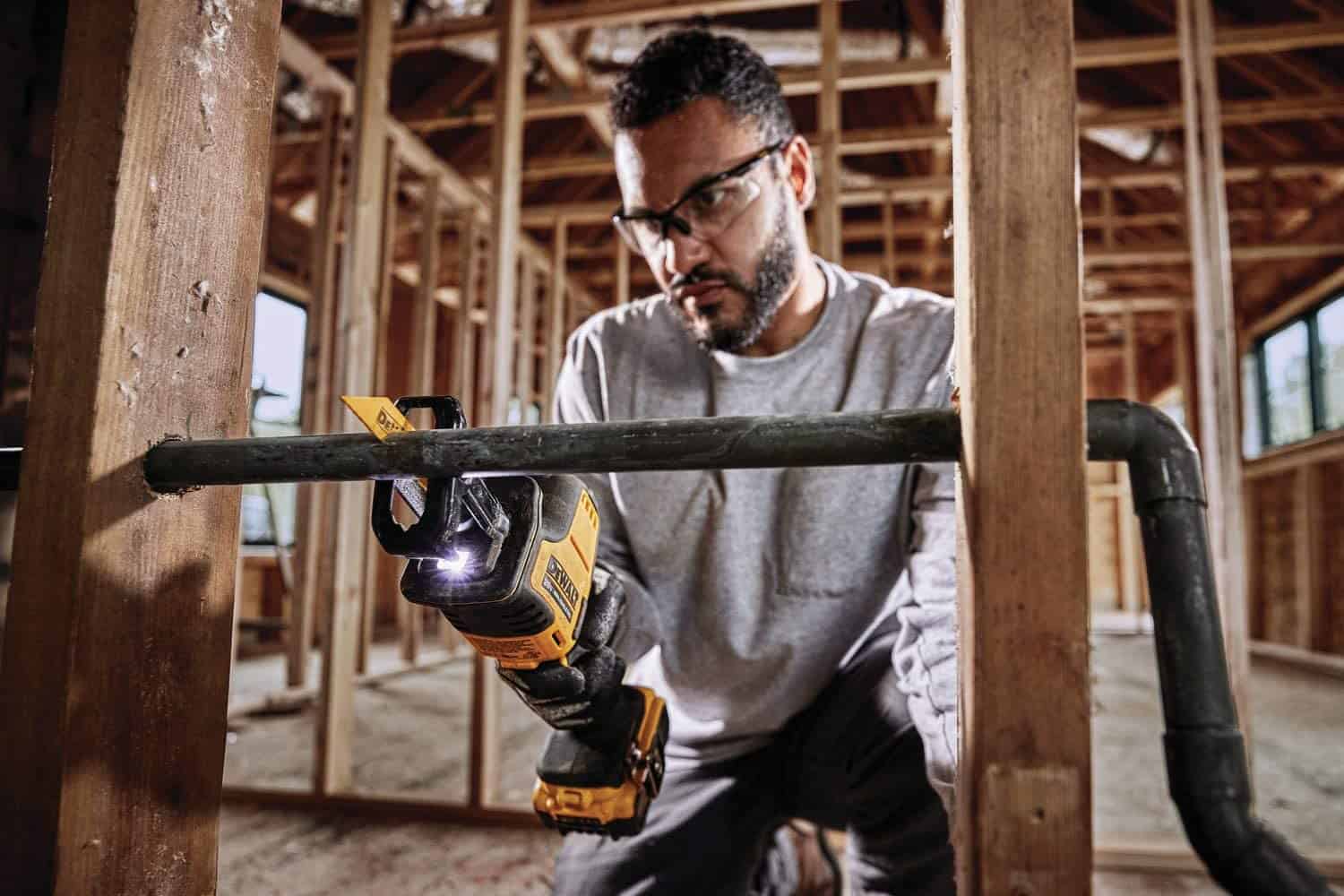
Let’s take a look at the specialized tools every HVAC toolset should contain.
- Vacuum pump – air and moisture can contaminate an HVAC system and cause corrosion or lower its efficiency. A vacuum pump allows an HVAC technician to get the non-condensable and air out of the system before introducing the refrigerant into the system or remove impurities from a recovered refrigerant.
- Manifold gauges – The valves and ports of manifold gauges grant you an overview of the refrigerant flow during the process of charging or evacuating an HVAC system. Bluetooth-enabled smart probes have largely replaced manifold gauges, but they still offer a simple way of monitoring the flow of a refrigerant.
- Leak detectors – Fuel or gas leakage is often why the HVAC system isn’t functioning properly. A leak detector allows you to determine if the system is losing gas or refrigerant so that you can detect the source of the problem quickly.
- Nitrogen regulator – Nitrogen purging is a part of the brazing process conducted during the system installation to check if the system is running normally. A nitrogen regulator lets you lower the pressure in a nitrogen tank and regulate its flow.
- Multimeter – You have to check the HVAC system’s voltage, resistance, and amperage before you can start repairing it. A multimeter is an essential part of your HVAC tool kit that enables you to perform the diagnostics of the system’s electrical installations.
- Psychrometer – High humidity levels can hamper the performance of HVAC systems, and measuring air humidity in the space in which you want to install this system will lower the chances of potential failure. You can also use psychrometers to determine the humidity level inside a malfunctioning HVAC system.
- Core removal tool – You have to remove valve cores to evacuate or recharge an HVAC system. This task becomes much easier if you perform it with a core removal tool that lets you detach the valve’s core without losing the charge.
A thermometer, a reciprocating saw, a caulking gun, or an electronic refrigerant scale are also among the HVAC tools to help you become more efficient at your job.
Hand tools
Unlike specialized HVAC tools, hand tools are usually not provided by employers, and every HVAC technician must have their own set of HVAC tools they use on the job. So here’s a brief overview of must-have HVAC hand tools.
- Flashlights – Ductwork is sometimes located in the crawl space and similar low-visibility spaces. Including a flashlight in your kit may prove to be crucial, as it will provide you with an additional source of light you can use whenever you need it.
- Screwdrivers – HVAC technicians fasten or unfasten huge amounts of screws as most components of HVAC systems contain different types of fasteners. Getting a set of screwdrivers with insulated handles will prepare you for a vast range of scenarios.
- Pliers – Wire strippers, open face, or needle-nose are some of the most common types of pliers you’ll have to use while managing the HVAC system’s wiring. Opting for models that come with insulated handles will improve your safety on the job.
- Cordless drills – Drilling through different surfaces are an integral part of the HVAC technician’s job, and a cordless drill will enable you to make holes wherever you want, even if you don’t have access to a power source.
- Wrenches – To open valves or handle pipes, you’ll need access to a wide range of wrenches. Check the common HVAC socket sizes to find out which wrench sizes are best suited for the job.
- Tape measure – Before you start installing an HVAC system, you first have to measure the dimensions of the space and make sure that all components of the system can fit in their place. That’s why a 25-foot tape measure is a standard tool in all HVAC toolkits.

Other types of HVAC tools
Although they are not needed on all HVAC installation, upkeep, or replacement jobs, these tools can come in handy if you’re struggling to fold a sheet metal or expand a tube.
Stashing these HVAC tools in your work van can prove to be a smart decision as you might find yourself in a situation where you need one of these tools urgently. So, let’s take a closer look at some of the most important miscellaneous HVAC tools.
- Staple guns – HVAC insulation installation process is usually slow and tiresome, but a staple gun can make it smooth and easy. Having a staple gun around can be useful, even if you don’t install HVAC insulation often.
- Extension cord – Completing an HVAC maintenance check without having access to power isn’t always possible, and you should have several extension cords of varying lengths with you to ensure that you have easy access to electricity regardless of the on-site conditions.
- Tin snips – HVAC removal projects can be challenging as uninstalling ductwork requires you to handle large quantities of sheet metal. A pair of tin snips will make it easier to cut through rivets or shape metal as you see fit.
- Awls – Puncturing rivet holes doesn’t have to be a tedious task, simply grab an awl and create holes wherever you want.
The safety equipment
Working with electrical equipment, pressurized refrigerants, and various power tools leaves a narrow margin of error. That’s why you must take precautionary measures and protect yourself from accidents that may occur while you’re on the job.

- Work shoes – Some parts of the HVAC systems are heavy, and they can hurt your feet badly if you drop them. Steel toe boots enable you to move over different terrains without difficulty, and they protect your feet from falling objects.
- Gloves – Handling installation materials with your bare hands can lead to an injury, which is why you should wear gloves during all tasks you perform. Choosing thin work gloves will enable you to use the high-precision tool effectively while keeping your hands safe.
- Goggles – Protective eyewear is an essential item in your HVAC safety equipment kit because it will ensure that a stray piece of metal can’t hurt your eyes.
- Earplugs – Power tools produce a lot of noise, and as an HVAC technician, you’ll be using drills and saws daily. Earplugs are going to keep your hearing intact even if you’re frequently working in noisy environments.
The benefits of HVAC starter kits
HVAC technicians who are just starting to build their toolkit should consider getting an HVAC starter kit that contains the essential tools they need to do their jobs.
In addition to a tool bag, you’ll also get a manifold, a thermometer, wrenches, and all other equipment you need to install or repair an HVAC system. Starter kits can also be a more budget-friendly option than purchasing each HVAC tool separately.
Bear in mind that the quality of the tools in the kit depends on the manufacturer, so you should avoid affordable options manufactured by unknown brands.
The most important factors to consider while choosing HVAC tools
Starting as an HVAC technician can be difficult as you might struggle to keep up with the job demands, especially if you haven’t completed an HVAC training course. That’s why you need a reliable set of HVAC tools that will enable you to do your job professionally.
It is pointless to get all the gear an HVAC technician might need since certain equipment is used only on specific jobs. Besides, your employer might provide specialized HVAC tools, so you won’t have to spend money on a leak detector or a vacuum pump.
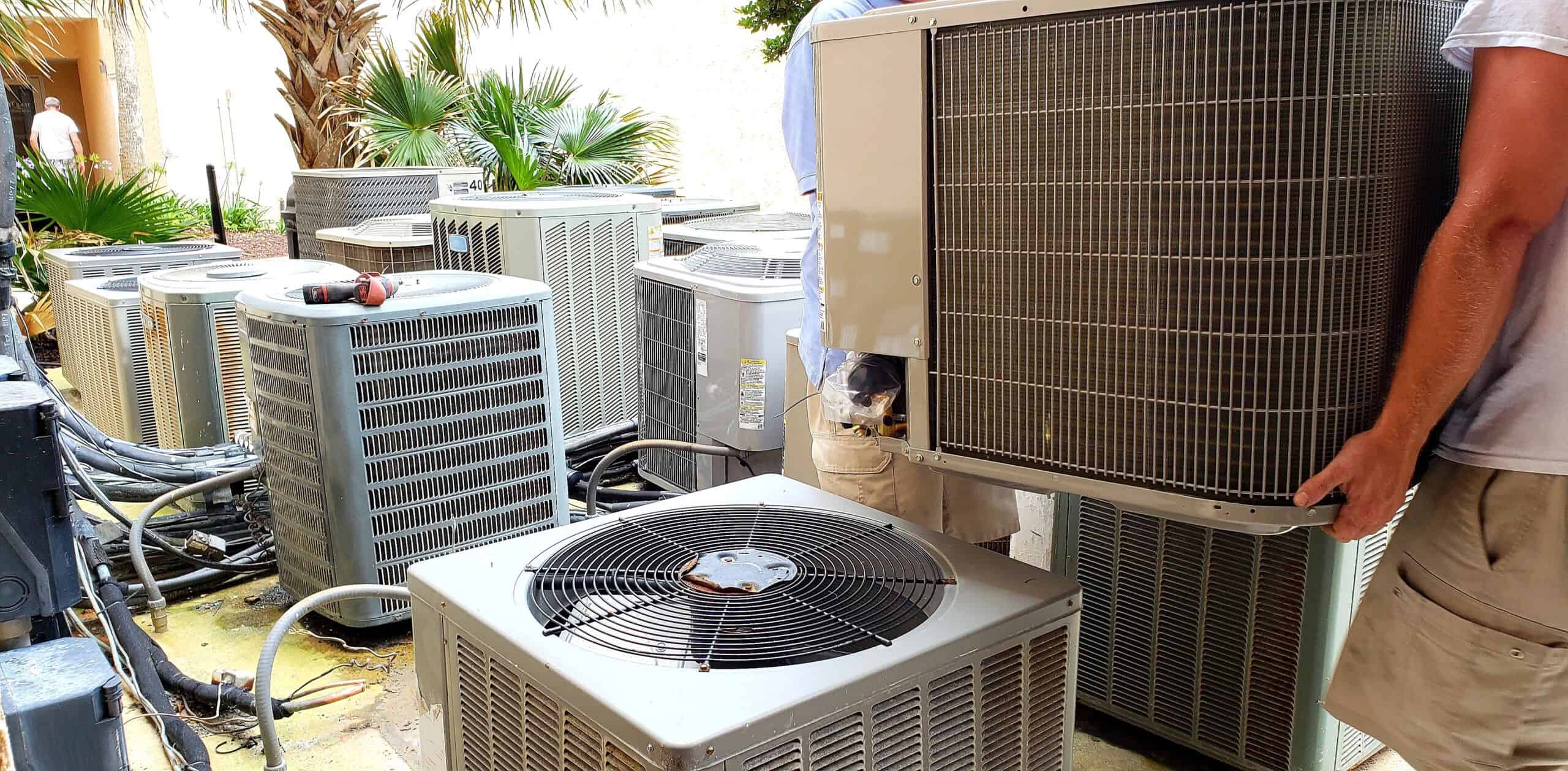
We’ve selected some of the most important factors you’ll have to consider while deciding which HVAC tools you should get.
Estimate the range of your toolkit
Carrying a heavy tool bag to every job site can be difficult and unnecessary since in most cases you will be using a few pieces of equipment. What’s more, the toolkit for managing a residential AC and installing a commercial HVAC system isn’t the same.
That’s why you should assess which HVAC tools you need to do your job efficiently and build your toolkit around the gear you’re using every day. Once you have the key pieces of an HVAC toolkit, you can start adding miscellaneous tools that may be useful in specific contexts.
Size and weight of individual tools
Some of the HVAC tools can be bulky and heavy, so you should check the weight and size of each tool you add to your kit. By doing so, you will lower the weight you have to carry with you on every job, and you’ll reduce the fatigue you experience while working long hours.
Opting for compact and lightweight HVAC tools will enable you to use smaller tool bags, which in turn will help you get rid of the clutter in your work van. Also, try to test every tool before buying it to see how they feel in your hand and how difficult it would be to use it in a confined space.
Features a tool offers
Reading the reviews, checking the specifications, or watching videos about the tool you’re interested in are some things you can do before you decide you want to purchase a particular tool model.
This is especially important while searching for specialized HVAC tools since, for example, choosing a smart probe over a manifold gauge can make your job easier in the long run. Also, the tool’s features should be able to make your work process more efficient.

Sadly, the quality of HVAC tools depends on the manufacturer, so you can’t just pick any tool because you might have to replace it soon.
In addition, you won’t be able to get all HVAC tools from the same brand, and you need to do some research to find out which brands are the best for the tool you’re looking for.
So, if you’re searching for a cordless drill, you should consider Makita or DeWalt brands, but if you need a psychrometer or smart probes, then TESTO or Fieldpiece brands should be your go-to options.
Durability and cost
As an entry-level HVAC technician, you’re likely to repair and install HVAC systems, which means that your toolkit should contain tools that enable you to perform both of these tasks.
An HVAC toolset designed for a technician costs between $200 and $300 and the sets designed for installers is similarly priced. Hence, you’ll have to spend around $500 to get both HVAC toolsets, and you should continue upgrading your HVAC tools as you gain more experience on the job.
The durability of HVAC tools depends on a wide range of factors, but if you take good care of your equipment, you won’t have to replace it for years.
The advantages of HVAC tools
Good HVAC tools can help you find a job faster.
The quality and the state of your HVAC tools can hint to your potential employer that you care about what you do because you care about the tools you’re using to do your job.
On the other hand, the equipment the employer issues to you can reveal how much they care about the tools their employees are using.
Most HVAC tools are easy to use
Handling HVAC tools doesn’t require a lot of skill or experience since using a thermometer, a reciprocating saw, or an electronic leak detector is an intuitive process. Also, getting used to working with nitrogen regulators and manifold gauges doesn’t take long.
All HVAC tools are reusable.
You won’t have to replace HVAC tools every time you use them. In fact, most pieces of HVAC toolsets can withstand years of heavy usage. However, you must check if the equipment you’re using is operational before you head out to a job site.
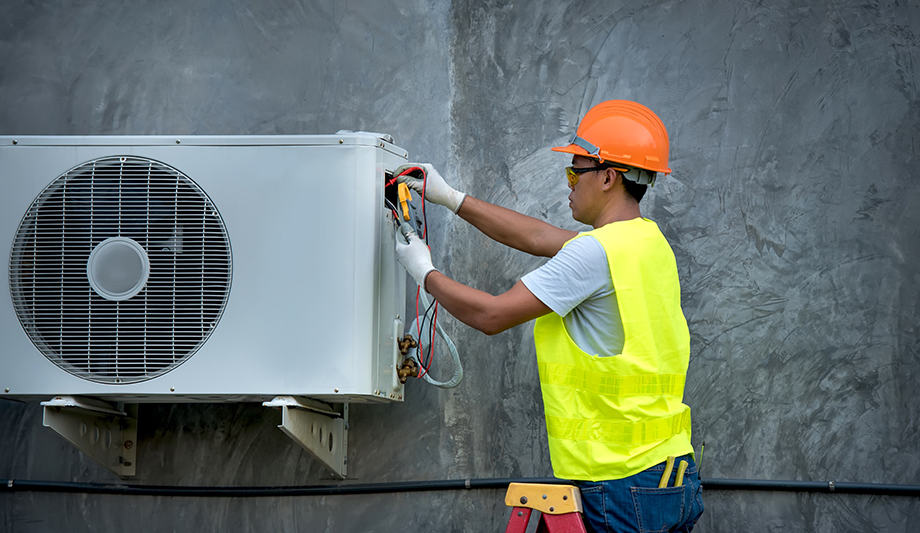
HVAC tools are easy to find
You won’t have to spend a lot of time searching for the HVAC tools that meet your expectations since there are so many models to choose from, either online or in brick-and-mortar stores.
HVAC tool kits are usually moderately priced
Given their range and the number of individual tools they include, HVAC tool kits are affordable, since, for less than $300, you can get all the equipment you need to install HVAC systems.
The disadvantages of HVAC tools
HVAC tools can be heavy
The weight of HVAC tools is incredibly important since in most situations you’ll be holding an HVAC tool in an unnatural and uncomfortable position. Unfortunately, some HVAC tools can get heavy if you’re holding them over your head for a long time.
HVAC toolsets can occupy a lot of space
On average, an HVAC toolset contains between ten and twenty different tools, so you’re going to need a lot of storage space if you want to build a full HVAC toolset.
Top 4 HVAC tool recommendations
Examining your daily routines is probably the best way to determine which HVAC tools you should add to your kit because the tools you choose should be suitable for the types of tasks you perform every day.
Even so, some HVAC tools are used by all HVAC technicians and installers, so you can hardly go wrong if you get a heat pump or a set of wrenches. We’ve selected several HVAC tools that could be worthy additions to your set of tools, so here’s what they have to offer.
Fieldpiece JL3RH Psychrometer
Equipped with a magnetic mount, the Fieldpiece JL3RH Psychrometer can be fitted on all metal surfaces with ease, enabling you to use it in tight spaces that are hard to reach. The psychrometer works with the Job Link app, which processes the data the JL3RH acquires and displays it on your smartphone.
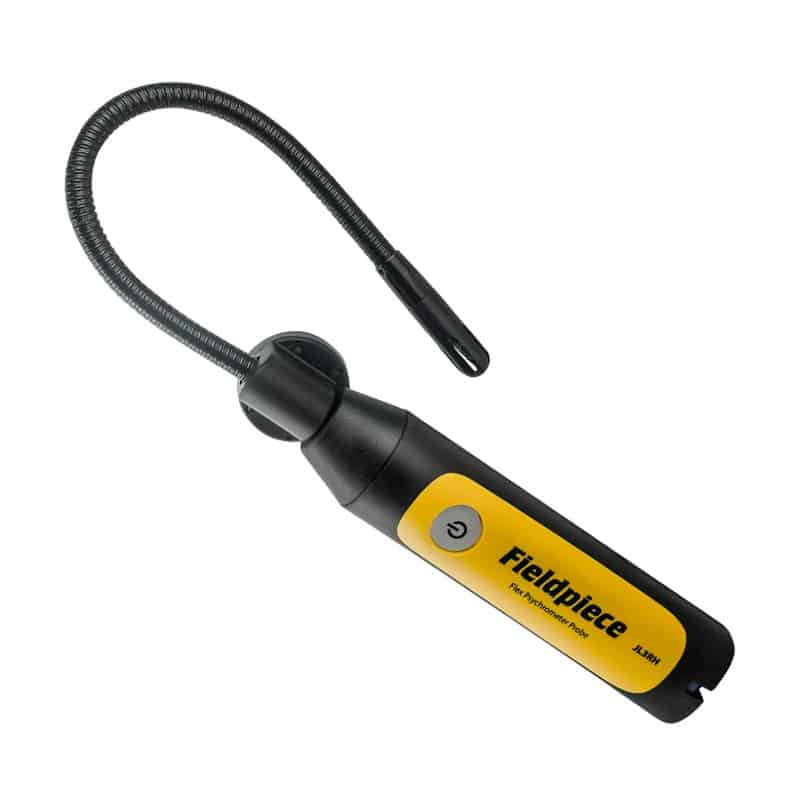
The model’s range is limited to 350ft, and it doesn’t need an app to establish communication with wireless manifolds. Regardless of the device, you pair it with; the psychrometer will grant you access to real-time readings.
TESTO Smart Probe Kit
Measuring the pressure in HVAC systems or checking the air temperature in ducts and all other spaces will be much easier you get the TESTO Smart Probe Kit. This kit includes the TESTO 605i thermohygrometer, TESTO 115i wireless thermometer, and TEST 549i pressure meter.
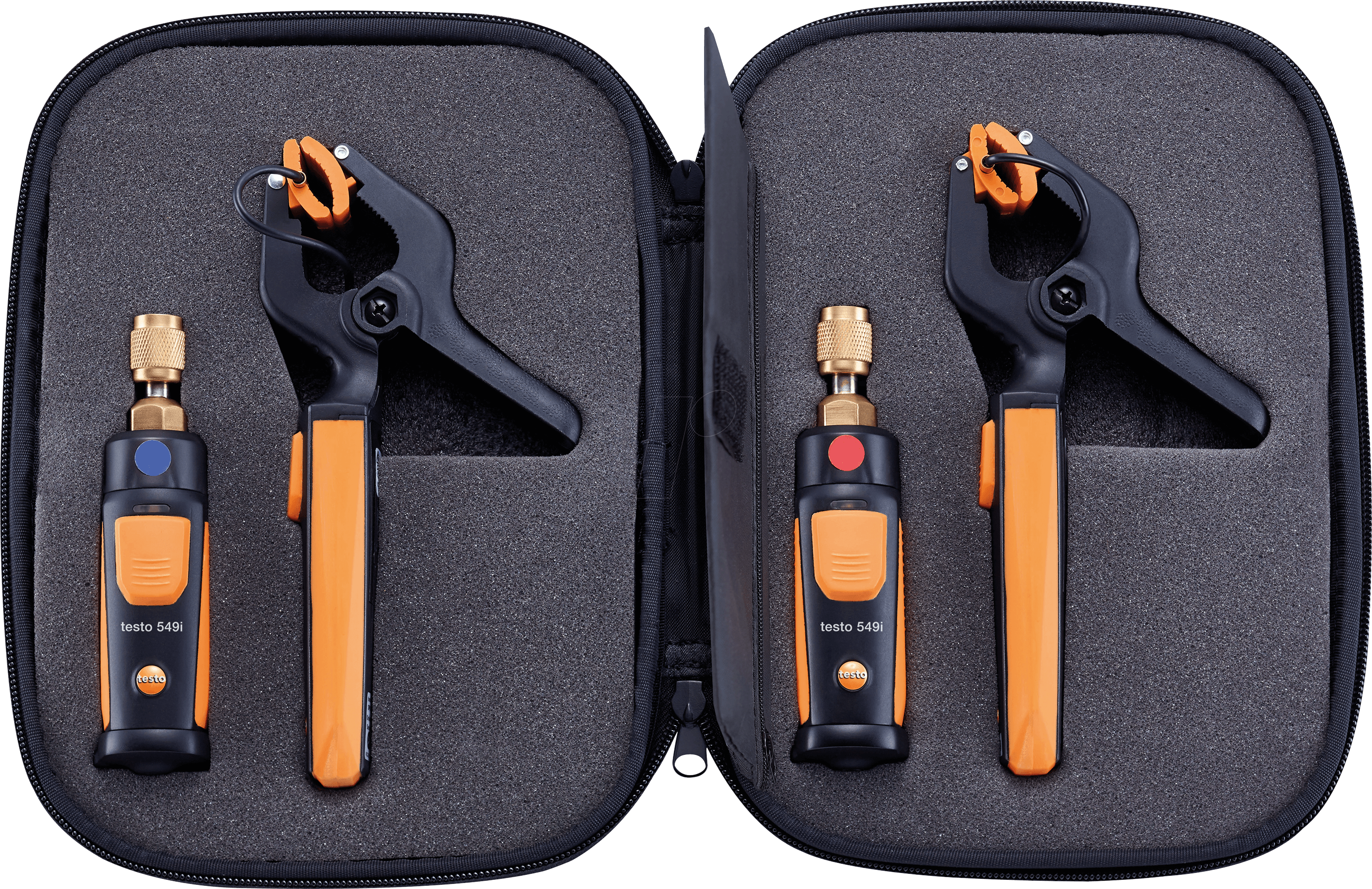
Hence, you’ll be able to measure the air humidity, air temperature, and pressure remotely by simply placing these instruments near a register or a crawlspace. All data you gather is displayed and stored in the Smart Probes app that also lets you create reports.
Elitech ILD-200 Leak Detector
Designed to respond to all types of halogenated refrigerants, the Elitech ILD-200 Leak Detector has a maximum sensitivity of 0.14oz/yr. This unit is equipped with an infrared sensor that can remain functional for up to 10 years, and you can switch between three sensitivity levels.

The ILD-200 features a TFT screen that displays the detected leakage level and enables you to instantly estimate the leakage scope. This leak detector runs on rechargeable lithium batteries that are included in the kit, and it weighs just 2.75lbs.
Elanco HVAC Technician Master Tool Kit
Instead of buying each HVAC tool separately, you can purchase the Elanco HVAC Technician Master Tool Kit and get all the tools you need to perform your daily tasks. This tool kit comes with a gauge manifold and a 60-inch hose that easily connects to an HVAC system.
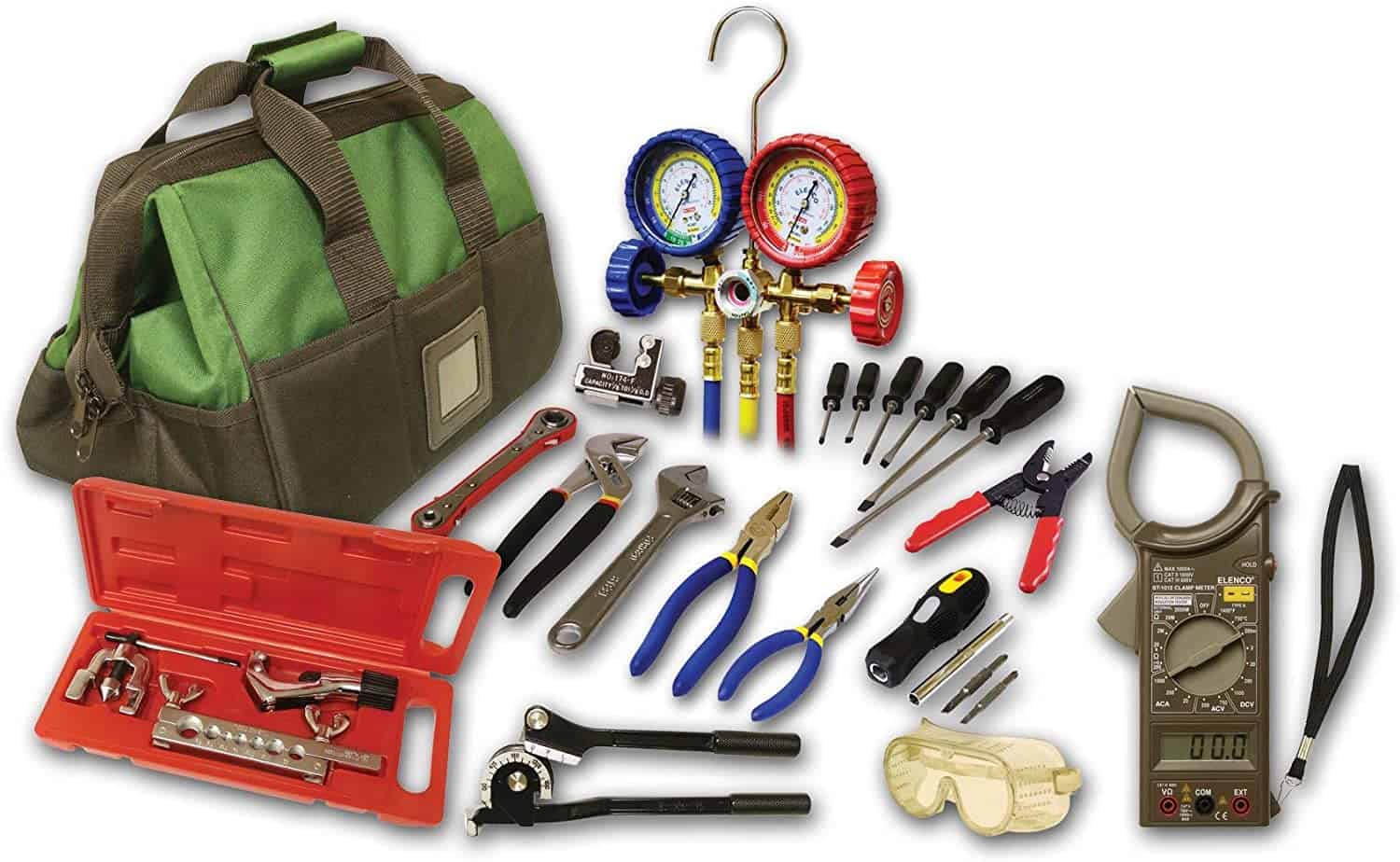
In addition, you’ll get a mini tubing cutter, tube working kit, a six-piece screwdriver set, 6-in-1 driver set. This Elanco’s HVAC tool kit also includes a pair of long nose pliers, linesmen pliers, a wire stripper, and an adjustable wrench.
All tools are stored in a portable tool bag that enables you to carry the kit with you to a job site.
Frequently asked questions about HVAC tools
Question: Can moisture damage HVAC tools?
Answer: Yes, it can. That’s why you have to wipe them clean after usage to get rid of lingering moisture and store them in a cold dark space.
Question: How often do I have to calibrate meters, monitors, and gauges?
Answer: You should calibrate your gauges, meters, and monitors at least once per year to ensure that the readings they provide are accurate.
Question: Do I need to get my own HVAC hand tools?
Answer: Employers usually issue just the specialized HVAC tools, so in most cases, you’ll have to use your hand tools on the job. However, some employers offer reimbursement or replacement option if your tools break down during working hours.
Question: How to know which HVAC tools I need to carry with me?
Answer: Each job is specific, and you’ll be briefed about the job’s requirements before you head out to the location, which will give you enough information to select the tools you want to bring with you.
Final thoughts: Choosing the right HVAC tools for your kit?
Evacuating a refrigerant from an AC or measuring the humidity level in the HVAC system is relatively easy if you have the right tools for the job. So, if you’re thinking about becoming an HVAC technician, one of the first things you’ll have to do is build your HVAC tool kit.
Even if you’re working for an HVAC service company, you’ll still need protective equipment, hand tools, and additional tools to perform your job professionally.
We recommend getting the Elanco HVAC Technician Master Tool Kit if you’re just starting your HVAC tool collection. In time, you can upgrade your kit with the TESTO Smart Probe Kit and the Elitech ILD-200 Leak Detector and improve your efficiency.
Hopefully, this article has provided you with the information you needed to find the best HVAC tools. Leave a comment and let us know.
- R13 vs R15 Insulation Compared: What’s the Difference? - December 9, 2023
- Ruud vs Trane HVAC Systems Compared - December 9, 2023
- Senville Mini Split Review and Guide: Is It Worth Buying? - December 9, 2023
